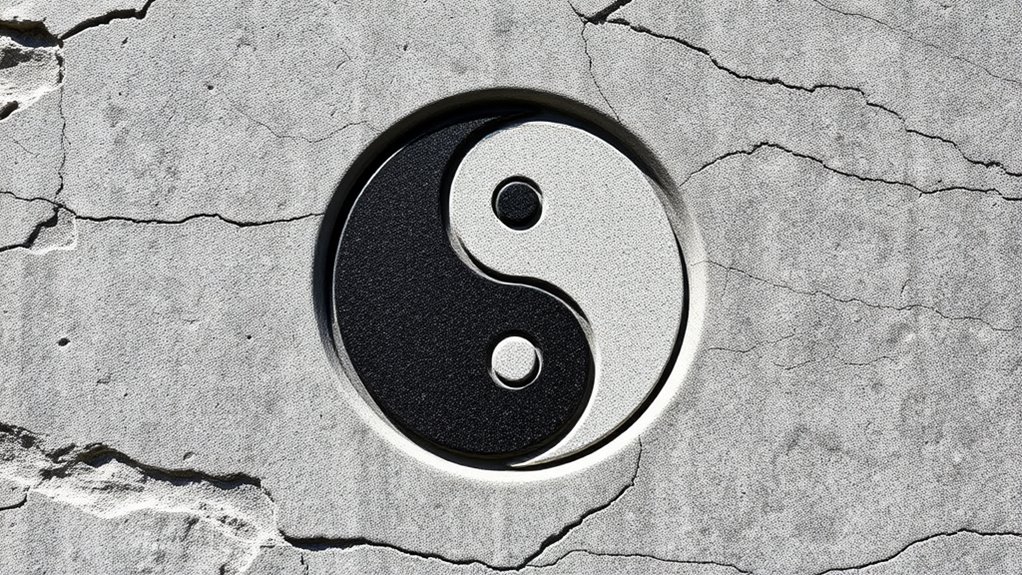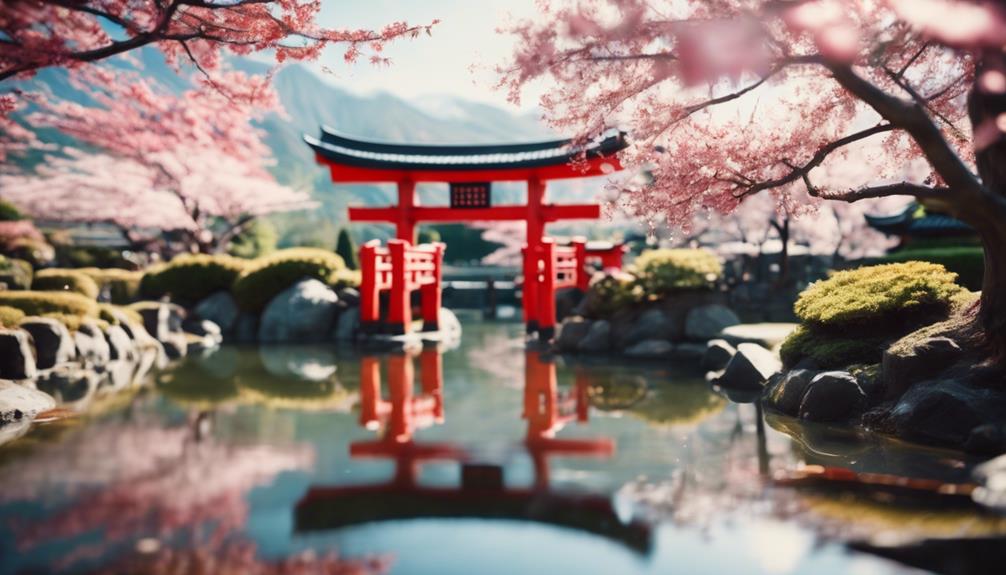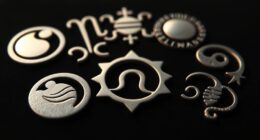Decoding yin-yang goes beyond seeing it as just black and white; it’s about understanding the constant flow and balance of opposing forces in life. You’ll find that strength can come from softness, and chaos from harmony. It emphasizes that everything contains elements of its opposite, and true balance emerges through ongoing adjustment and acceptance. If you explore further, you’ll discover how this philosophy applies to all aspects of existence, revealing deeper layers of interconnectedness.
Key Takeaways
- Yin-Yang represents dynamic balance and interconnected dualities, not just black or white, emphasizing harmony within contrasts.
- It reflects the natural cycle of opposing forces that flow and transform into each other, maintaining equilibrium.
- Understanding Yin-Yang involves appreciating softness, flexibility, and cooperation as sources of strength and power.
- True harmony arises from embracing contradictions and adjusting constantly rather than seeking static solutions.
- Beyond color symbolism, Yin-Yang symbolizes interconnectedness, natural order, and the fluid balance of life’s opposing elements.

Have you ever wondered what the ancient concept of Yin-Yang truly represents? It’s more than just black and white symbols; it’s a profound philosophy about the nature of existence. At its core, Yin-Yang embodies the idea of balance and harmony, emphasizing that opposing forces are interconnected and interdependent. When you look beyond the simple dichotomy, you see a duality philosophy that teaches us everything contains a bit of its opposite. It’s not about dominance or conflict but about understanding how contrasting elements coexist to create wholeness.
Yin-Yang reveals how opposing forces interconnect to create harmony and wholeness in life.
In your daily life, this duality philosophy plays out constantly. Think about day and night, hot and cold, life and death — these aren’t isolated phenomena but parts of an ongoing cycle. Yin and Yang aren’t static; they flow into each other, transforming and maintaining equilibrium. This fluidity reminds you that nothing is entirely one thing or the other, and that true harmony arises when you accept and embrace these contradictions. When you recognize the balance between these forces, you gain a deeper appreciation for the natural order of things.
Yin-Yang also signifies that strength often comes from softness, and power from flexibility. For instance, in relationships or personal growth, it’s not about overpowering but about cooperation and adaptability. The philosophy encourages you to see the value in contrast — quietness and activity, patience and action — understanding that each complements the other. Achieving harmony isn’t about erasing differences but integrating them seamlessly. You’re invited to view conflicts or challenges as opportunities for balance, where opposing energies can work together to create stability.
This perspective shifts your approach to problems, urging you to find equilibrium rather than forcing a single solution. It emphasizes that harmony is a dynamic process, requiring ongoing adjustment and awareness. When you internalize this duality philosophy, you realize that life’s complexities don’t need to be feared; instead, they can be appreciated as essential parts of a larger, interconnected system. Recognizing the interconnectedness of opposing forces can deepen your understanding of how balance functions in various aspects of life.
Yin-Yang teaches you that embracing the full spectrum of existence, including its contradictions, leads to a more authentic, balanced life.
Frequently Asked Questions
How Does Yin-Yang Influence Modern Health Practices?
Yin-yang influences modern health practices by emphasizing holistic balance and energy flow. You’re encouraged to view health as a harmony between opposites, like rest and activity, or diet and exercise. Practitioners focus on restoring this balance through techniques like acupuncture, yoga, or mindfulness. By understanding energy flow and maintaining equilibrium, you can promote overall well-being and prevent illness, aligning with the core principles of yin-yang philosophy.
Can Yin-Yang Principles Apply to Personal Relationships?
While some see relationships as black and white, you can apply yin-yang principles to foster balance and harmony. Embrace emotional dynamics by understanding that both strength and vulnerability coexist. You’ll find that embracing opposites—trust and independence, closeness and space—helps deepen connections. By recognizing these contrasting energies, you create a partnership rooted in mutual respect, where harmony naturally emerges from balancing differing needs and emotions.
Is Yin-Yang Relevant in Contemporary Western Philosophy?
You might wonder if yin-yang still holds relevance in contemporary Western philosophy. It does, through philosophical integration and cultural adaptation, offering a framework to balance opposing ideas like chaos and order. Western thinkers are increasingly embracing these concepts to enrich understanding of dualities in ethics, psychology, and social dynamics. By applying yin-yang, you can see how ancient wisdom adapts to modern debates, fostering harmony amid complexity.
How Do Different Cultures Interpret Yin-Yang Concepts?
Did you know that over 70% of cultures incorporate some form of dualism? Different cultures interpret yin-yang concepts through unique lenses, shaping their philosophical interpretations and cultural symbolism. In Western traditions, it often symbolizes balance and harmony, while in other Eastern cultures, it emphasizes interconnectedness and transformation. Exploring these diverse perspectives reveals how the yin-yang concept transcends borders, offering a universal framework for understanding life’s dualities.
What Are Common Misconceptions About Yin-Yang Symbolism?
You might think yin-yang is just about black and white, but it’s really about balance and harmony. Many believe it solely represents duality or opposition, yet it also signifies unity and interconnectedness. A common misconception is that yin and yang are completely separate or opposing forces, when in fact, they complement each other, maintaining equilibrium. Understanding this helps you see that yin-yang embodies the ongoing harmony of life’s dual aspects.
Conclusion
Now you see, yin and yang aren’t just black and white; they’re the dance of shadows and light, swirling in perfect harmony. Embrace the subtle nuances, for life’s true balance hides in the delicate interplay between opposing forces. Like a moonlit night softly revealing the stars, understanding deepens when you look beyond surface contrasts. So, step into the dance, and let the yin-yang rhythm guide you through the beautiful mystery of coexistence.










